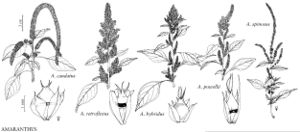Amaranthus powellii
Proc. Amer. Acad. Arts 10: 347. 1875.
Plants glabrous or moderately pubescent toward inflorescences, becoming glabrescent at maturity. Stems usually erect, green or sometimes reddish purple, branched, mainly in inflorescences, to nearly simple, 0.3–1.5(–2) m, stiff. Leaves: petiole mostly equaling or longer than blade; blade rhombic-ovate to broadly lanceolate, 4–8 × 2–3 cm, occasionally larger in robust plants, base cuneate to broadly cuneate, margins entire, apex cuneate to obtuse or indistinctly emarginate, with mucro. Inflorescences mostly terminal, usually with spikes at distal axils, erect and rigid, green to silvery green, occasionally tinged red, leafless at least distally. Bracts lanceolate to linear-subulate, 4–7 mm, 2–3 times as long as tepals, rigid. Pistillate flowers: tepals usually 3–5, not clawed, unequal; outer tepals narrowly ovate-elliptic or elliptic, 1.5–3.5 mm, apex aristate; style branches spreading, shorter than body of fruit; stigmas 3. Staminate flowers clustered at tips of inflorescence branches; tepals 3–5; stamens 3–5. Utricles subglobose or compressed-ovoid, 2–3 mm, equaling or shorter than tepals, smooth or lid slightly rugose or minutely verrucose, dehiscence regularly circumscissile. Seeds black, subglobose to lenticular, 1–1.4 mm diam., smooth, shiny.
Phenology: Flowering summer–fall.
Habitat: Disturbed habitats, agricultural fields, railroads, roadsides, waste areas, banks of rivers, lakes, and streams
Elevation: 0-2500 m
Distribution
Alta., B.C., Ont., P.E.I., Que., Sask., Ariz., Ark., Calif., Colo., Conn., Fla., Idaho, Ill., Ind., Kans., Ky., La., Maine, Mass., Mich., Minn., Miss., Mo., Mont., Nev., N.H., N.J., N.Mex., N.Y., N.C., Ohio, Okla., Oreg., Pa., R.I., S.C., S.Dak., Tenn., Tex., Utah, Vt., Va., Wash., W.Va., Wis., Wyo., Mexico, introduced or naturalized in South America, Eurasia, Australia.
Discussion
Amaranthus powellii is originally native to southwestern United States and adjacent regions of Mexico; now, it is widely naturalized almost everywhere in temperate regions of North America. The distribution of A. powellii is probably underestimated both in North America and the Old World, and literature references are somewhat confusing, because A. powellii has been commonly confused with A. hybridus.
Forms of Amaranthus powellii with indehiscent or occasionally irregularly dehiscent utricles were described from Europe (southwestern France, the Gironde estuary) as A. bouchonii Thellung. Similar forms occasionally occur in North America. According to J. M. Tucker and J. D. Sauer (1958) and J. D. Sauer (1967b, 1972b), they are mostly “mutant or aberrant forms” of A. powellii, or hybrids of A. powellii and/or A. hybridus with other species. Recent comparative studies of morphology and isozymes of A. bouchonii (P. Wilkin 1992) indicated that that taxon, whatever its origin was, now differs from its presumably parental species and probably deserves recognition, at least as a separate subspecies. It seems that in North America, the situation with indehiscent-fruited forms is much more complicated than in Europe, and multiple entities are involved, including deviate forms of A. powellii and also partly sterile hybrids of dioecious taxa with species belonging to the A. hybridus group. The formal recognition of A. bouchonii in North American material would be premature.
The names Amaranthus hybridus, A. chlorostachys Willdenow, and A. hybridus subsp. chlorostachys (Willdenow) Hejný were occasionally misapplied to A. powellii in North America and Europe.
Selected References
None.
